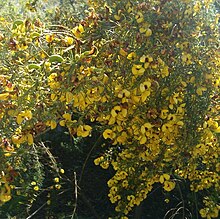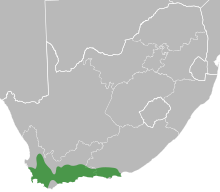| Cyclopia | |
|---|---|

| |
| Cyclopia meyeriana | |
| Scientific classification | |
| Kingdom: | Plantae |
| Clade: | Tracheophytes |
| Clade: | Angiosperms |
| Clade: | Eudicots |
| Clade: | Rosids |
| Order: | Fabales |
| Family: | Fabaceae |
| Subfamily: | Faboideae |
| Tribe: | Podalyrieae |
| Genus: | Cyclopia Vent.[1] |
| Sections and species | |
|
See text | |

| |
| Cyclopia is endemic to South Africa. | |
| Synonyms[2] | |
| |
Cyclopia, the honeybush, or heuningbos in Afrikaans, is a genus of some 20 species of flowering plants in the legume family Fabaceae, subfamily Faboideae. Species of the genus are native to the southern and southwestern Cape Provinces of South Africa.[3]
Its description was published by the French botanist Étienne Pierre Ventenat in 1808. The name Ibbetsonia, published two years later, is regarded as a synonym of this genus;[4] John Sims had commemorated the physiologist Agnes Ibbetson with this name.[4]
Cultivation and use[edit]
The leaves of honeybush are commonly used to make herbal teas. It grows only in small areas in the southwest and southeast of South Africa and has many similarities with rooibos. Honeybush and rooibos are considered types of red tea.
Honeybush is so named because the flowers smell of honey. The taste of honeybush tea is similar to that of rooibos but a little sweeter. In some rural districts, it used to be common practice to keep a kettle of honeybush tea infusing on the stove ready for drinking while scenting the whole house—unlike tea prepared from Camellia sinensis, the product does not turn bitter with long-term simmering.
There are dozens of species of honeybush tea found in the wild, of which about four or five are in widespread home or commercial use. These are:[5][6][7]
- Cyclopia intermedia, known as 'bergtee' (mountain tea), found between Port Elizabeth and the edge of the Langkloof
- Cyclopia genistoides, known as 'kustee' (coastal tea), found mostly in the Western Cape near Yzerfontein and Darling and also thriving in the South Cape if cultivated
- Cyclopia maculata, grown in the Outeniqua area near George
- Cyclopia sessiliflora, known as 'Heidelberg-tee', named after the town Heidelberg in South Africa, where it grows in the local mountain range
- Cyclopia subternata, known as 'vleitee' (marshland tea) or 'valleitee' (valley tea)
- Cyclopia longifolia[8]
Some species can be cultivated whereas others have resisted all attempts at cultivation and must be harvested in the wild. It is not always easy to discover what the seeds need to enable them to germinate; some kinds bear elaiosomes and might be dependent on the services of particular ants or birds. Cyclopia intermedia (mountain tea) is one of the teas that is harvested in the Kouga mountains where it grows naturally. Mountain tea regenerates within three years after harvesting or devastation by fire; consequently less than one third of the mountain yield is available for harvesting each year by rotation.[9]
Mountain tea and valley tea flower in September/October whereas coastal tea flowers in May/June.[10]
Tea preparation[edit]
There are two methods of processing honeybush for use in tea. In the traditional method, the leaves of the bush are harvested, cut and bruised (often with mechanical rollers), and then left in the sun to oxidise. The modern, industrialised process oxidises the leaves in rotating, heated tanks at temperatures of 70–90 °C for two to three days. The leaves are then air-dried.
Afterwards, the leaves are sifted and graded according to the application:
- Super Fine (mostly used for string-and-tag tea bags)
- Regular Fine (mostly used for swimming tea bags or loose tea application)
- Coarse (mostly used for loose tea application)
Chemistry[edit]
Honeybush is low in tannin (0.45%). Some of the bioactive compounds present in honeybush include:[11][12]
- isoflavones
- flavones
- cinnamic acids
- coumestans
- xanthonoids
- mangiferin and isomangiferin (Cyclopia subternata)
Species[edit]
Cyclopia comprises the following species:[2][13][14]
Section Aequalis[edit]

- Cyclopia burtonii Hofmeyr & E. Phillips
- Cyclopia buxifolia (Burm. f.) Kies
- Cyclopia laxiflora Benth.
Section Cyclopia[edit]
- Cyclopia alpina A.L. Schutte
- Cyclopia falcata (Harv.) Kies (= Cyclopia subternata Vogel) [15]
- Cyclopia galioides (Bergius) DC.
- Cyclopia genistoides (L.) Vent.
- Cyclopia intermedia E. Mey.
Section Marsupium[edit]
- Cyclopia latifolia DC.
- Cyclopia sessiliflora Eckl. & Zeyh.
- Cyclopia squamosa A.L. Schutte
Section Praegnans[edit]
- Cyclopia alopecuroides A.L. Schutte
- Cyclopia aurescens Kies
- Cyclopia bolusii Hofmeyr & E. Phillips
- Cyclopia bowieana Harv.
- Cyclopia glabra (Hofmeyr & E. Phillips) A.L. Schutte
- Cyclopia meyeriana Walp.
Section Truncatae[edit]
- Cyclopia filiformis Kies
- Cyclopia longifolia Vogel
- Cyclopia maculata (Andrews) Kies
- Cyclopia plicata Kies
- Cyclopia pubescens Eckl. & Zeyh.
References[edit]
- ^ "Cyclopia". International Plant Names Index (IPNI). Royal Botanic Gardens, Kew; Harvard University Herbaria & Libraries; Australian National Botanic Gardens. Retrieved 14 October 2010.
- ^ a b Schutte AL (1997). "Systematics of the genus Cyclopia Vent". Edinburgh J Bot. 54 (2): 125–170. doi:10.1017/S0960428600004005.
- ^ Cyclopia Vent. Plants of the World Online. Retrieved 16 August 2023.
- ^ a b Boulger, George Simonds (1891). . In Lee, Sidney (ed.). Dictionary of National Biography. Vol. 28. London: Smith, Elder & Co.
Ibbetsonia, Curtis's Botanical Magazine (t. 1259, 1810)
- ^ "Agricultural Research Council—Botanical information". arc.agric.za. Archived from the original on 22 February 2012. Retrieved 16 September 2012.
- ^ Kamara, B. Irene; Brand, D. Jacobus; Brandt, E. Vincent; Joubert, Elizabeth (August 2004). "Phenolic Metabolites from Honeybush Tea (Cyclopia subternata)". Journal of Agricultural and Food Chemistry. 52 (17): 5391–5395. doi:10.1021/jf040097z. PMID 15315375. INIST 16036960.
- ^ "Agri-Probe" (PDF). www.elsenburg.com. Archived from the original (PDF) on 22 February 2012. Retrieved 16 September 2012.
- ^ "Cyclopia longifolia - Useful Temperate Plants". temperate.theferns.info. Retrieved 14 September 2021.
- ^ [1] Archived October 3, 2006, at the Wayback Machine
- ^ "Honeybush Tea—Organic Honeybush Tea is caffeine free". www.montegotea.com. Retrieved 16 September 2012.
- ^ de Beer D, Jerz G, Joubert E, Wray V, Winterhalter P (2009). "Isolation of isomangiferin from honeybush (Cyclopia subternata) using high-speed counter-current chromatography and high-performance liquid chromatography". J Chromatogr A. 1216 (19): 4282–9. doi:10.1016/j.chroma.2009.02.056. hdl:10033/71233. PMID 19272608.
- ^ Kokotkiewicz A, Luczkiewicz M (2009). "Honeybush (Cyclopia sp.)—a rich source of compounds with high antimutagenic properties". Fitoterapia. 80 (1): 3–11. doi:10.1016/j.fitote.2008.11.001. PMID 19032980.
- ^ "ILDIS LegumeWeb entry for Cyclopia". International Legume Database & Information Service. Cardiff School of Computer Science & Informatics. Retrieved 25 February 2014.
- ^ USDA; ARS; National Genetic Resources Program. "GRIN species records of Cyclopia". Germplasm Resources Information Network—(GRIN) [Online Database]. National Germplasm Resources Laboratory, Beltsville, Maryland. Archived from the original on 24 September 2015. Retrieved 25 February 2014.
- ^ "Cyclopia falcata (Harv.) Kies — the Plant List".
External links[edit]
 Data related to Cyclopia at Wikispecies
Data related to Cyclopia at Wikispecies Media related to Cyclopia at Wikimedia Commons
Media related to Cyclopia at Wikimedia Commons- Honeybush by Subhuti Dharmananda, Ph.D., Director, Institute for Traditional Medicine, Portland, Oregon
- Honeybush by Liesl van der Walt, South African National Biodiversity Institute. Relates mostly to coastal honeybush, Cyclopia genistoides.